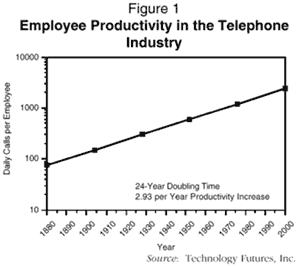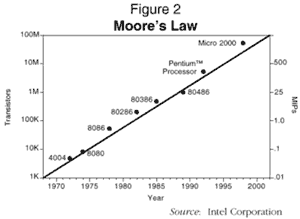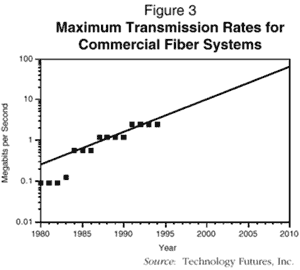
Decisions of this type, i.e., ones with possible dramatic consequences based on a commitment to a technology with uncertain potential, have become increasingly common in today's telecommunications environment. Examples include IBM's investment in Asynchronous Transfer Mode (ATM) technology, PCS PrimeCo's commitment to Code Division Multiple Access technology, and Hughes Electronics' investment in DirecTV. Each of these decisions was based on a myriad of factors -- technical, financial, legal, social, and so on. However, three of the most important factors driving these decisions were:
Questions such as these have always been prevalent in business decisions which involve new technologies. What is different today, however, is that the pace of technical advance is so rapid that decisions often have to be made despite a great deal of uncertainty about each of the factors. To make rational decisions under these conditions, executives have to be able to forecast future trends, events, and circumstances with reasonable reliability and timeliness.
Fortunately for these decision makers, a number of techniques, commonly grouped together under the designation technology forecasting (TF), have been developed over the last three decades to assist in defining future business and technical realities. From a practical standpoint, these techniques have provided significant assistance to decision makers forced to deal with uncertain future environments such as those characterizing the telecommunications industry today. Technology Futures' experience in the application of TF to project developments in the telecom industry has supported our belief in the efficacy of these techniques. We are convinced that the well-considered use of TF can be of considerable value to key people in the industry. Therefore, we plan to publish a series of articles on technology forecasting in future issues of NTQ. This first article will concentrate on one commonly-used forecasting technique. Future issues will examine other TF techniques, methods for employing the results of forecasts, and suggestions for integrating TF activities into corporate operations.
Dr. Eric Jantz, one of the pioneers in the practice of technology forecasting, once identified over 150 different TF techniques. However, at present, there are some 18 to 20 techniques being used by various business and government organizations for practical forecasting purposes. Basically, all forecasting efforts involve an extrapolation of past experience, modified by subjective judgment about how the future will be different from the past. Thus, all forecasting techniques involve methods for:
Experience has shown that, for most new technologies, advances in key technical parameters occur at a constant percentage rate over a significant part of their development life. That is to say, if a given parameter was improved by 5% last year, it can be expected to be improved by an additional 5% next year and 5% the year after that. Such constant percent improvement represents exponential improvement in the parameter over time. Another representation of exponential growth is the phenomenon of "constant doubling time" -- if it takes five years for the value of a parameter to double from 10 to 20, one can expect a further doubling from 20 to 40 in another five years.2 Figure 1 demonstrates this phenomenon for the average number of telephone calls processed per telephone company employee over the last century. One of the interesting characteristics of exponential improvement is that it is reflected as a straight line on semilog graph paper. This characteristic makes it easier to identify patterns of progress and to extrapolate them into the future.

Another interesting aspect of trend extrapolation is the wide variety of technical areas in which it has been found to apply. In our experience, we have been able to utilize the technique in many industries and applications such as:
Probably the most widely known example of trend extrapolation is Moore's Law. In the late 1970s, Dr. Gordon Moore, then president of Intel, projected that, for the foreseeable future, the number of transistors per computer chip would double every two years.3 This projection has proven to be amazingly accurate from the Intel 4004 chip in 1972 through the Pentium in 1992. Moreover, popular press reports indicate that Intel is basing its plans for the follow-on Micro 2000 chip on the continuation of the trend through the end of the century (see Figure 2). Another example of the use of trend extrapolation in the telecom industry is shown in Figure 3, which illustrates increased transmission rates for commercial fiber systems.


When using this approach in practice, the forecaster first seeks to find those characteristics (or groups of characteristics) of the technology that are key to its performance. Examples might include:
Once these key characteristics have been determined, appropriate measurement parameters must be identified. For example, parameters for the previous listed characteristics might be:
The forecaster then uses curve fitting techniques to determine if a pattern of past progress can be identified. As previously noted, experience has shown that a common development pattern is exponential improvement over time. Finally, the forecaster extrapolates the pattern of advance for an appropriate time into the future to make the forecast. In the common case of exponential progress, this extrapolation involves the extension of a straight line on a semilog-curve plot.
When appropriately used, trend extrapolation can be useful for:
The technique has also been found useful in a number of indirect uses. For example, a major energy company used it to estimate the future prices of petroleum. In the early 1970s, many industry experts were projecting continuing dramatic increases in price through the end of the century. These projections were based on the hypotheses that demand for oil would continue to grow rapidly, while the supply would remain essentially constant. Hence, many knowledgeable practitioners were projecting costs of $50, $75, $100, and, in some cases, as high as $200 a barrel. Forecasters in one company, however, surmised that higher oil prices would themselves motivate oil conservation measures and, therefore, questioned the supposition of drastically increasing demand. These forecasters used trend analysis to project improvements in fuel use efficiency by a number of major consumers -- automobiles, manufacturers, airlines, plastic producers, etc. The sum of these projections indicated a significant slowing in the growth of demand and, hence, a stabilization of oil prices in the $15 to $20 per barrel range. Although these projections were not particularly popular with corporate management, they proved to be quite accurate and helped to prevent some very inappropriate management decisions.
THE LIMITATIONS OF TREND EXTRAPOLATION
Although trend extrapolation, when used appropriately, can be of definite value to business and government decision makers, it does not, of course, solve all forecasting problems. Obvious questions are: How does the forecaster know if past trends will continue into the future? If they do continue into the future, how long will they persist? (Simple logic dictates that no exponential process can continue indefinitely.) To address these questions, the forecaster must go back to the basic premise of trend analysis -- that progress in technology is determined by certain driving forces such as the need for improvement, advances in supporting technology, societal needs and desires, available budgets, and so on. It is presumed that, as long as these driving forces remain essentially intact, the pattern of technical advance will follow past trends. Obviously, if the driving forces change, the pattern of technological progress will probably also change. Thus, in utilizing trend extrapolation, forecasters must, to the extent possible, define the key driving forces. Moreover, they must continually be on the alert for emerging changes in these driving forces. In practice, one of the major advantages of good trend analysis projects is that they often support the identification and evaluation of key driving forces for change. A well conducted effort can often help in defining and formulating critical questions.
Experience in the use of trend extrapolation has provided some "rules of thumb" that can be useful for the practitioner. For example, it has been found that projections can usually be extended with relative confidence for a period of about half as long as the trend has continued in the past. For example, if data indicates that the trend has held for 10 years, one can reasonably expect that it will continue for at least five more years. This rule of thumb can only be employed, however, if it is anticipated that the following circumstances will prevail:
For example, the ever-increasing needs for data transmission capacity will undoubtedly continue to drive advances in fiber optic cable efficiency. Quantum mechanic interactions will eventually limit minimum conductor separation on computer chips as presently formulated. Increasing reliance on digital techniques will limit the development of analog equipment.
There are two other limits to the use of trend analysis in forecasting that should be pointed out. The first of these is that, by its nature, trend analysis requires the availability of reliable, applicable time-series data. It has been the experience of the authors that, in many cases where we have considered the use of trend extrapolation, such data was not available, was not reliable, or was irrelevant. In some cases, usable data can be reconstructed or implied, or surrogate data can be used. However, without question, the better and more extensive the data available, the more reliable and credible the forecast results will be.
The other limit on the value of this technique is the fact that its results do not indicate how the projected technical advance will be accomplished. It can indicate the probable capacity of future personal communications systems, but it will not specify what technologies will be available to meet those needs. It can project the cost of video communications systems by the year 2005, but it will not tell how that goal will be reached. This limit is, of course, a significant disadvantage. However, the bright side is that forecasting that a given level of technical capability will be achieved at an indicated point in time can often assist in identifying possible technical solutions. For example, a projection of needs for transmission capacity beyond that offered by fiber optic cable might lead forecasters to examine R&D activities in the high temperature superconductor area. A limit to clear transmission distances for fiber optic cables might lead forecasters to examine progress in passive amplifiers. A concern about chip capacity in ATM switches might lead to examination of less chip-intensive techniques.